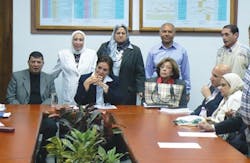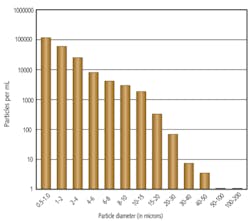Membrane Biorector Systems Getting the Right Fit
When selecting Membrane Bioreactor (MBR) technology many options exist. To help with the process Andrew Harris provides a brief description of system configurations and case studies.
The use of membrane bioreactor (MBR) technology for wastewater treatment has increased rapidly over the past decade. Drivers such as small available footprints, stringent effluent regulations and the desire to reuse treated effluent have contributed to this increasing trend. Although a broad range of sizes and configurations of MBR systems are available in the marketplace, most of the options provided by MBR system vendors fall into the following categories: custom systems consisting of membrane equipment only, custom systems consisting of biological and membrane equipment, pre-engineered packaged systems consisting of membrane equipment only and pre-engineered packaged systems consisting of biological and membrane equipment.
Custom systems: membrane equipment only
When the biological process design and equipment are provided by others, the MBR vendor's scope of supply is typically limited to membranes; filtrate and air headers; filtrate, backwash and/or clean-in-place (CIP) pumps; and instruments, valves and controls critical to the operation of the membrane system.
In many instances, ancillary equipment such as air scour blowers, chemical feed skids and air compressors that are used by the membrane system but can be easily supplied by others are omitted from the MBR vendor's scope. Membrane tanks for larger plants are typically made of concrete and provided by the contractor. And components supplied by the MBR vendor are typically shipped loose and installed in the field.
This MBR system option is best suited for end users wishing to retrofit their existing plants with membrane filtration, as the existing biological treatment infrastructure can often be reused. It is also often used when the consulting engineer takes on the biological process design responsibility.
The city of Healdsburg, for instance, opted to only install membranes at its wastewater treatment facility in California, U.S.. The city was ordered to construct an advanced treatment facility by a U.S. court decision in 2004. The city, in conjunction with its consultant, HDR, and contractor, Overaa, constructed an MBR facility in 2008, which included Siemens membranes. This plant is designed for an average daily flow of 6.1 million liters per day (MLD) (6,100 m3/day) and a peak flow of 15.1 MLD (15,100 m3/day). Design influent and effluent parameters and typical measured effluent quality are provided in Table 1. The scope of supply for this MBR system included membranes, filtrate pumps, valves and instruments for five concrete membrane tanks. A process schematic and a view of the membrane tanks are shown in Figures 1 and 2, respectively.
Figure 1. Process schematic of Healdsburg, California MBR
Figure 2. Membrane tanks for Healdsburg Wastewater Treatment Facility.
Custom systems: entire MBR
When an MBR vendor supplies the entire MBR system, in addition to the membranes and ancillary components previously described, the scope may include all major equipment associated with the biological process. This can include mixers, recirculation pumps, biological blowers, aeration devices, valves and instrumentation. Similar to the membrane-only option, MBR vendors typically ship this equipment loose for field assembly by a contractor.
If the end user and its consulting engineer are looking to reduce overall process risk, they may seek an MBR vendor that can supply the entire MBR system.
This risk reduction is achieved by assigning both the biological and membrane process risk to the MBR vendor in the form of performance guarantees for effluent quality and hydraulic capacity. This is in contrast to the membrane-only scope of supply, where the MBR vendor takes on only the risk associated with membrane filtration.
The Upper Hocking Water Pollution Control Facility in Lancaster, Ohio, USA, incorporated innovative biological processes into its MBR system. The city of Lancaster and its consultant, Malcolm Pirnie, selected an MBR using Siemens' Vertical Loop Reactor (VLR) system, Cannibal solids reduction system and MemPulse membrane filtration (Figure 3). This plant, which started up in July 2011, was designed for an average daily flow of 7.6 MLD (7,600 m3/day) and a peak hourly flow of 22.7 MLD (22,700 m3/day).
Figure 3. Process schematic for Upper Hocking Water Pollution Control Facility, Lancaster, Ohio. (source: City of Lancaster)
A summary of the design influent and effluent parameters is provided in Table 2. The facility can handle increased flows from future development and can divert flow from existing combined sewer overflows (CSOs). Effluent from the facility is discharged to the Hocking River.
Packaged systems: membrane equipment only
Several MBR vendors offer packaged membrane filtration systems. These systems typically include a steel or stainless steel membrane tank, membrane components, and filtrate pump and associated piping. Some vendors supply everything pre-piped and pre-wired on a skid, minimising installation time and expense.
Figure 4. VLR® Basins at Upper Hocking Water Pollution Control Facility, Lancaster, Ohio.
There are, of course, many available options, such as filtrate storage tanks, air scour blowers, and chemical feed skids for cleaning the membranes. Packaged, membrane-only systems are typically used for plants with average daily flows of less than 19 MLD (19,000 m3/day). They are particularly useful for projects requiring low installation costs and short construction schedules. An example of a packaged unit is shown in Figure 5.
Figure 5. Example of packaged membrane-only system (MemStationTM by Siemens).
Packaged Systems, Entire MBR
In addition to packaged membrane-only systems, MBR vendors offer packaged systems that include the entire MBR. These systems often include a pre-screen, anoxic and aerobic biological process tanks, membrane tanks, recycle and filtrate pumps, blowers and controls (Figure 6). Similar to the membrane-only packaged systems, some vendors supply everything pre-piped and pre-wired, while others supply the system in several pieces. These packaged units are typically designed for up to 380,000 liters per day (38 m3/day) of average daily flow and to provide an effluent with less than 5 milligrams per liter (mg/l) of biological oxygen demand (BOD) and total suspended solids (TSS) and less than 10 mg/l total nitrogen (TN) when treating typical municipal wastewater. Options are typically available to achieve lower TN effluent limits and phosphorus limits.
Figure 6. Process schematic for Xpress packaged MBR system.
Complete packaged MBR systems may be selected:
- To reduce process risk from the standpoints of the consulting engineer and owner
- To make the most efficient use of limited available footprint
- To comply with a short installation schedule
- To allow the equipment to be relocated and reused after the treatment objectives have been met at the initial installation site
- To minimise the engineering design and installation/startup costs
- To provide an effective form of decentralised treatment for such uses as residential developments, schools, restaurants, parks, and golf courses
- To permit the treatment system to be "hidden" inside a small building that blends in with the surrounding architecture.
The Grey Eagle Casino in southwest Calgary, Alberta, Canada took delivery of Siemens' XpressTM packaged MBR system. Among other things, this project required minimal construction labor due to labor shortages, a tight installation schedule, TN and total phosphorus (TP) effluent limits, and the ability to simply drop the treatment system into a pre-constructed building through removable roof panels (Figure 7). This plant is designed to treat an average daily flow of 200,000 L/day (200 m3/day) and has been meeting all its discharge requirements (TN < 10 mg/l, TP < 0.5 mg/l) since it started up in October 2007.
Figure 7. A packaged MBR system at Grey Eagle Casino in Calgary, Alberta.
Conclusion
There are a variety of options available in the marketplace for MBR systems, and these options are being offered by an increasing number of manufacturers. The option best suited for a particular project depends upon project and site-specific conditions. Coordination with the MBR vendor from the earliest stages in the project design through startup and operation is essential to a successful MBR installation. WWi
About the Author: Andrew (Andy) J. Harris, P.E. is an MBR product engineer for Siemens Industry Inc.'s Water Technologies Business Unit. For more information email: [email protected].
More Water & WasteWater International Archives Issue Articles




